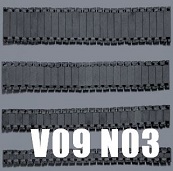Abstract
The use of qualitative models in small-scale presents itself as an essential tool for teaching structural systems as it allows the direct observation of the deformations in the model, therefore promoting the understanding of the mechanical behavior in an intuitive and clear way. In this sense, this work develops an analysis of the existing didactic qualitative models aiming the development of a simple and low cost qualitative model that should be capable of promoting an intuitive understanding of the mechanical behavior of the structures and, at the same time, presents enough flexibility to allow the experimentation of various structural possibilities. This model proposes to serve as a tool for learning through the visualization of the mechanical behavior of the structures. The observation of the deformations, twists, and arrows may allow the correlation of the intuitive experience of the phenomena with the numerical simulations traditionally carried out in the process of structural design. Finally, the article presents the results obtained, in which the developed model proved herself to be very promising, promoting a rich first contact with the structural behavior besides a good qualitative exploration of the structural possibilities.References
ALLEN, E.; ZALEWSKI, W. Form and Forces: designing efficient, expressive structures. New Jersey: Wiley, 2010.
ENGEL, E. Sistemas de Estruturas. Barcelona: Gustavo Gili, 2001.
EVANS, P.; SILVER, P.; MCLEAN, W. Sistemas Estruturais. São Paulo: Blucher, 2009.
FRANCO, M. O papel da história no ensino da teoria das estruturas. In: ENCONTRO DE PROFESSORES DE ESTRUTURA PARA ESCOLAS DE ARQUITETURA, 1., São Paulo, 1974. Anais... São Paulo: FAUUSP, 1974. p.1-7.
HARRIS, H; SABNIS, G. Structural Modeling and Experimental Techniques. Boca Raton: CRC Press, 1999.
HOSSDORF, H. Model analysis of structures. New York: Van Nostrand Reinhold, 1974.
LOBOSCO, T. Modelos Didáticos para Exploração e Compreensão Estrutural. In: ENCONTRO NACIONAL DE ENSINO DE ESTRUTURAS EM ESCOLAS DE ARQUITETURA, 3,. Ouro Preto, 2017. Anais... Ouro Preto: UFOP, 2017. p.796-809.
MARGARIDO, A. Fundamentos de Estruturas. São Paulo: Zigurate, 2003
NERVI, P. L. Lenguage arquitectónico. Buenos Aires: FADU, 1951.
OLIVEIRA, M. Modelo Estrutural Qualitativo para Pré-Avaliação do Comportamento de Estruturas Metálicas. 2008. 172 f. Dissertação (Mestrado em Engenharia Civil), Escola de Minas, Universidade Federal de Ouro Preto, Ouro Preto, 2008.
PRAVIA, Z.; ORLANDO, D. Modelos qualitativos de treliças planas: Construção e aplicação no ensino da análise e comportamento estrutural. In: CONGRESSO BRASILEIRO DE ENSINO DE ENGENHARIA, 29., Porto Alegre, 2001. Anais... Porto Alegre: PUC-RS. 2001. p.9-14.
RODRIGUES, P. F.; HERMIDA, A. Modelagem de elementos básicos de estruturas para a análise qualitativa do comportamento estrutural. Revista de Ciência e Tecnologia, Nova Iguaçu, v. 6, n. 1, jun. 2006.
SARAMAGO, R. C. P. Ensino de estruturas nas escolas de Arquitetura do Brasil. 2011. Dissertação (Mestrado) – Escola de Engenharia de São Carlos, Universidade de São Paulo, São Carlos, 2011.
SALVADORI, M. The Art of Construction: projects and principles for beginning engineers & architects. Chicago: Chicago Review Press, 1990.
REBELLO, Y. A Concepção Estrutural e a Arquitetura. São Paulo: Zigurate, 2000.
SCHODEK, D.; BECHTHOLD, M. Structures. Noida: Person India, 2015.
TORROJA, E. Razón y Ser de los Tipos Estructurales. Madrid: Consejo Superior de Investigaciones Científicas, 1957.
I accept that PARC Research in Architecture and Building Construction journal perform, on the original file approved for publication, revisions and modifications in orthoghaphic, grammar and standard issues.
I give to PARC Research in Architecture and Building Construction journal the rights of first publication of the revised version of my paper, licensed under the 'Creative Commons Attribution' license (which allows sharing the work with the recognition of first authorship and publication in this journal).


